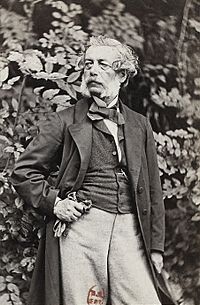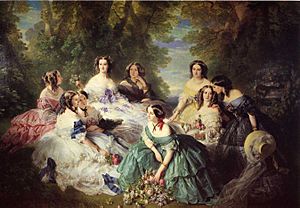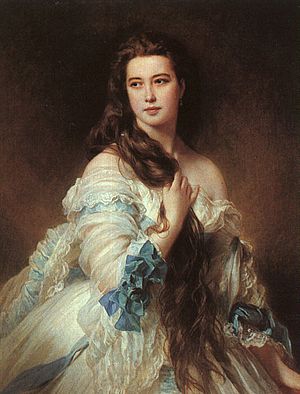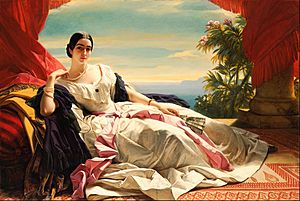Franz Xaver Winterhalter facts for kids
Quick facts for kids
Franz Xaver Winterhalter
|
|
|---|---|

Winterhalter in 1865
|
|
| Born | 20 April 1805 Menzenschwand, Black Forest, Electorate of Baden
|
| Died | 8 July 1873 (aged 68) |
| Nationality | German |
| Known for | Painting, litography |
| Signature | |
Franz Xaver Winterhalter (born April 20, 1805 – died July 8, 1873) was a German painter. He was famous for painting beautiful portraits of kings, queens, and rich people in the mid-1800s. His name is now linked with fancy court portraits.
Some of his most well-known paintings include Empress Eugénie Surrounded by her Ladies in Waiting (1855). He also painted famous portraits of Empress Elisabeth of Austria (1865).
Contents
Franz Winterhalter's Early Life
Franz Xaver Winterhalter was born on April 20, 1805. He grew up in a small village called Menzenschwand in Germany's Black Forest. His father, Fidel Winterhalter, was a farmer. Franz was the sixth of eight children, but only four lived past infancy. He stayed very close to his family, especially his brother Hermann, who was also a painter.
When he was 13, in 1818, Franz left home to study drawing and engraving. He learned how to draw and make lithographs in a workshop in Freiburg im Breisgau. At 18, in 1823, he moved to Munich. A rich businessman, Baron von Eichtal, helped him.
In 1825, he received money from Grand Duke Ludwig I of Baden. This allowed him to study at the Academy of Arts in Munich. He found a good teacher in the popular portrait painter Joseph Karl Stieler. To support himself, Winterhalter also worked as a lithographer.
Franz Winterhalter started working for royal families in 1828. He became a drawing teacher for Sophie Margravine of Baden in Karlsruhe. In 1832, he got the chance to travel to Italy. He spent 1833-1834 there with help from Grand Duke Leopold. In Rome, he painted romantic scenes. He also spent time with the director of the French Academy, Horace Vernet.
When he returned to Karlsruhe, he painted portraits of Grand Duke Leopold and his wife. He was then named the official painter for the grand-ducal court. However, he soon moved to France. His painting Il dolce Farniente was shown in Paris in 1836 and got a lot of attention. Another painting, Il Decameron, was also praised a year later.
In 1838, he showed a portrait of the Prince of Wagram and his young daughter. His career as a portrait painter really took off that same year. He painted Louise Marie of Orleans, the Queen of the Belgians, and her son. This painting likely helped him get noticed by Maria Amalia of the Two Sicilies, the Queen of the French.
Becoming a Court Painter
In Paris, Winterhalter quickly became very popular. He was chosen as the official court painter for Louis-Philippe, the King of the French. The King asked him to paint many portraits of his large family. Winterhalter ended up painting more than thirty works for him.
Because of this success, Winterhalter became known as the expert in painting portraits of royal and noble families. He was good at making people look like themselves, but also making them look very flattering. He could also make official portraits look modern and stylish.
However, art critics did not think highly of Winterhalter's work. They had praised his early paintings in 1836, but later said he was not a serious artist. This opinion stayed with him throughout his career. Winterhalter himself thought his royal paintings were just a short break. He hoped to go back to painting other subjects that were more respected. But he was so successful as a portrait painter that he kept doing it for the rest of his life. This made him very rich. Winterhalter became famous around the world and was supported by many royal families.

One of his many royal clients was Queen Victoria of England. Winterhalter first visited England in 1842. He returned many times to paint Victoria, Prince Albert, and their growing family. He painted at least 120 works for them. Many of these paintings are still in the Royal Collection today. You can see them at Buckingham Palace and other royal homes. For example, Florinda is at Osborne House. Queen Victoria gave it to Prince Albert for his birthday in 1852.
Winterhalter also painted some portraits of rich people in England. Most of them were part of the royal court. When King Louis-Philippe lost power in 1848, it did not hurt Winterhalter's career. He went to Switzerland and worked in Belgium and England.

Winterhalter managed to stay successful even when one royal family fell and another rose to power. Paris remained his home until a few years before he died. He never married and was very dedicated to his art.
After Napoleon III became emperor, Winterhalter became even more popular. During the Second French Empire, he was the main portrait painter for the imperial family and the French court. The French Empress Eugénie loved to have him paint her. She was very generous to him.
In 1855, Winterhalter painted his most famous work: The Empress Eugénie Surrounded by her Ladies in Waiting. He showed the Empress in a beautiful outdoor setting, gathering flowers with her ladies. This painting was highly praised and shown at a big art exhibition in 1855. It is still Winterhalter's most famous painting.
In 1852, he traveled to Spain to paint Queen Isabella II and her daughter. Rich Russian visitors to Paris also wanted their portraits painted by the famous artist. As the "Painter of Princes," Winterhalter was always in demand. He painted for the courts of Britain, Spain, Belgium, Russia, Mexico, Germany, and France. In the 1850s and 1860s, he painted many important portraits of Polish and Russian nobles. In 1857, he painted Tsarina Maria Alexandrovna.
During the Second Mexican Empire in the 1860s, Emperor Maximilian I of Mexico asked Winterhalter to paint portraits of him and his wife. The Empress of Mexico, Charlotte of Belgium, was the daughter of Louise-Marie of France. Winterhalter had painted Louise-Marie early in his career. Some of Winterhalter's paintings of the Mexican rulers are still in their palace in Mexico City, Chapultepec Castle. This is now the National Museum of History.
Later Years of Franz Winterhalter

Winterhalter had so many requests for portraits that he used many assistants. No other portrait painter had ever been so popular with royal families. Only famous artists like Rubens and Van Dyck worked with such a wide network of clients.
Winterhalter took breaks from his busy work by going on holidays. He visited Italy, Switzerland, and especially Germany. Even though he lived in France for many years, he always felt a strong connection to his home country. Despite his success, Winterhalter lived a simple life. In 1859, he bought a house in Baden-Baden, which was his favorite vacation spot.
In 1864, Winterhalter made his last visit to England. That autumn, he went to Vienna. There, he painted portraits of Emperor Franz Joseph and Empress Elisabeth. These are some of his most famous works. As he got older, Winterhalter's ties to France became weaker. He became more interested in Germany.
He was in Switzerland when the Franco-Prussian War started. This war ended the Second French Empire. After the war, Winterhalter did not go back to France. Instead, he went to Baden. He was still officially connected to the court of Baden and settled in Karlsruhe. In the last two years of his life, Winterhalter painted very little. He visited Frankfurt am Main in the summer of 1873. He became sick with typhus and died on July 8. He was 68 years old.
Winterhalter's Painting Style
Winterhalter became a very skilled portrait painter during the Second French Empire. He created his best work in the last twenty years of his life. His style matched the fancy and relaxed mood of that time. His paintings of women from the 1850s and 1860s look different from his earlier works. They seem more open and confident. However, his paintings of men were not as unique or memorable.
Serious art critics never gave Winterhalter high praise. They often said his work was too shallow and fake, just to be popular. But his royal clients loved his paintings very much. Royal families from England, France, Spain, Russia, Portugal, Mexico, and Belgium all asked him to paint their portraits. His large paintings made him very famous. Copies of his portraits made using lithography also helped spread his fame.
Winterhalter's portraits were valued because they felt personal and real. It's easy to see why people liked them. He created the image his subjects wanted to show to the world. He was not only good at posing people to make dramatic pictures, but he was also amazing at showing the texture of fabrics, furs, and jewelry. He paid as much attention to these details as he did to the faces. He painted very quickly and smoothly. He often drew his ideas directly onto the canvas without making many sketches first. His portraits are elegant, refined, lifelike, and beautifully idealized.
Winterhalter's way of working was unique. He was so good at drawing people that he painted right onto the canvas. He often decided what clothes the person would wear and how they would pose. His style was smooth, worldly, and believable. Many of his portraits were copied in his studio or made into lithographs.
As an artist, he was hard to categorize. There are few painters like him, and he doesn't fit into any specific art movement. His early work was similar to Neoclassicism, but his later style is often called Neo-Rococo. After he died, his paintings became less popular. People thought they were too romantic, shiny, and superficial. Not much was known about him personally, and his art was not taken seriously until recently.
However, a big exhibition of his work in London and Paris in 1987 brought him back into the spotlight. Today, his paintings are shown in major museums in Europe and America.
Images for kids
-
Queen Victoria and Prince Albert's family in 1846 by Franz Xaver Winterhalter. Left to right: Prince Alfred (at two years old); the Prince of Wales; Queen Victoria; Prince Albert; and Princesses Alice, Helena and Victoria.
Selected Artworks
- A Swiss Girl from Interlaken
- A Young Girl called Princess Charlotte, 1864
- Adelina Patti, 1863
- Albert Edward, Prince of Wales, 1846
- Albert Edward, Prince of Wales
- Albert, Prince Consort, 1859
- Alexandra Feodorovna, 1856
- Alexandra Iosifovna, Grand Duchess of Russia, Princess Alexandra of Altenburg
- Alexandra, Princess of Wales, 1864
- Alfred Emilien, Comte de Nieuwerkerke, 1852
- Anna Dollfus, Baronness de Bourgoing, 1855
- Antoine-Marie-Philippe-Louis d'Orleans Duc de Montpensier, 1844
- Arthur Wellesley, 1st Duke of Wellington with Sir Robert Peel, 1844
- Barbara Dmitrievna Mergassov-Rimsky-Korsakova, 1864
- Caroline Elisabeth de Lagrange, 1841
- Charles Jerome, Comte Pozzo di Borgo, 1849
- Charlotte Stuart, Viscountess Canning, 1849
- Charlotte, Princess of Belgium
- Carlota, Empress of Mexico (Princess Charlotte of Belgium)
- Chopin
- Count Jenison Walworth, 1837
- Countess Alexander Nikolaevitch Lamsdorff, 1859
- Edouard Andre, 1857
- Elisabeth Kaiserin von Österreich, 1865
- Elizabeth, Empress of Austria, 1865
- Elzbieta Branicka, Countess Krasinka and her Children, 1853
- Emperor Don Maximiliano I of Mexico, c. 1865
- Emperor Frederick III of Germany, King of Prussia with his wife Empress Victoria, and their children Prince William and Princess Charlotte, 1862
- Emperor Napoleon III
- Empress Elisabeth of Austria in dancing dress, 1865
- Empress Eugenie
- Empress Eugenie, 1853
- Empress Eugenie, Surrounded by her Ladies-in-Waiting, 1855
- Eugénie de Montijo, Empress of France, 1857
- Eugénie, Empress Consort of the French, 1864
- Eugenie, Empress of the French
- Florinda, 1853
- Francois Ferdinand Philippe d'Orleans Prince de Joinville, 1843
- Francois-Horace, 1841
- Franz Joseph I, Emperor of Austria wearing the dress uniform of an Austrian Field Marshal with the Great Star of the Military Order of Maria Theresa, 1865
- Frubling
- Girl from Sabin Mountains, 1840
- Grand Duchess of Russia, Olga Feodorovna
- Grand Duchess Olga
- Harriet Howard, Duchess of Sutherland, 1849
- Helene-Louise de Mecklembourg-Schwerin, Duchess of Orleans with his son Count of Paris, 1839
- Henri Eugene Philippe Duc d'Aumale, Commander of the 17th Battalion of the Light Infantry
- His Royal Highness Prince Albert
- Il dolce Farniente, 1836
- Italian woman with child
- Jadwiga Potocka, Countess Branicka
- Kaiserin Auguste
- Karl Josef Berkmuller, 1830
- La Siesta, 1841
- Lady Clementina Augusta Wellington Child Villiers, 1857
- Leonilla Wittgenstein, 1849
- Leopold I
- Leopold I, 1840
- Leopold, Duke of Brabant
- Linden d'Hooghvorst, 1855
- Louis Philippe, 1841
- Louis Philippe I, King of the French, 1840
- Louis-Charles-Philippe of Orleans Duke of Nemours, 1843
- Louis-Philippe I, King of France
- Ludwig, Graf Von Langenstein, 1834
- Maria Carolina de Borbó Dues Sicílies
- Maria Cristina di Borbone, Princess of the Two Sicilies, c. 1818
- Maria Louise of Wagram Princess of Murat, 1854
- Maria Luisa von Spanien, 1847
- Marie Christine d'Orléans
- Marie Henriette of Austria
- Markgräfin Sophie von Baden, 1830
- Maximiliaan van Oostenrijk
- Maximilian
- Melanie de Bussiere, Comtesse Edmond de Pourtales, 1857
- Painting of baby Princess Alice of the United Kingdom
- Painting of the Count of Eu as a child
- Pauline Sandor, Princess Metternich, 1860
- Pincess Clothilde von Saxen Coburg, 1855
- Portrait équestre de François Adolphe Akermann, 1870
- Portrait of a lady, 1872
- Portrait of a Lady, 1860
- Portrait of a lady with a fan, 1850
- Portrait of a lady with roses in her hair, (Countess Pushkina)
- Portrait of Amélie of Leuchtenberg
- Portrait of Augusta of Saxe Weimar Eisenach
- Portrait of Charlotte of Belgium, 1864
- Portrait of Charlotte of Belgium, 1864
- Portrait of Count Alexei Bobrinsky, 1844
- Portrait of Countess Olga Shuvalova, 1858
- Portrait of Countess Varvara Musina-Pushkina
- Portrait of Eliza Franciszka of Branicki Krasińska, 1857
- Portrait of Emperor Napoleon III, 1855
- Portrait of Empress Maria Alexandrovna, 1857
- Portrait of Eugénie, Empress of the French, 1862
- Portrait of Francisca Caroline de Braganca, 1844
- Portrait of Francisca Caroline Gonzaga de Bragança, princesse de Joinville, c. 1850
- Portrait of Grand Duchess Maria Nikolayevna, 1857
- Portrait of Grand Princess Yelena Pavlovna, 1862
- Portrait of HRH Princess Marie Clementine of Orleans, 1832
- Portrait of Infanta Luisa Fernanda of Spain, Duchess of Montpesier, c. 1847
- Portrait of Katarzyna Potocka, 1854
- Portrait of Katarzyna Potocka née Branicka, wife of Adam Potocki, c. 1850
- Portrait of Lady Middleton, 1863
- Portrait of Leonilla, Princess of Sayn Wittgenstein, 1843
- Portrait of Leopold I of Belgium, 1846
- Portrait of Louis d'Orleans, 1845
- Portrait of Louises von Orléans, 1841
- Portrait of Lydia Schbelsky Baroness Stael Holstein, 1857
- Portrait of Madame Ackerman, the wife of the Chief Finance Minister of King Louis Philippe, 1838
- Portrait of Madame Rimsky-Korsakov, Varvara Dmitrievna Mergassov, 1864
- Portrait of Marie Louise, the first Queen of the Belgians, c. 1841
- Portrait of Maximilian I of Mexico
- Portrait of Prince Albert, 1843
- Portrait of Prince Henri, Duke of Aumale, c. 1843
- Portrait of Princess Elizaveta Alexandrovna Tchernicheva, 1857
- Portrait of Princess Elizaveta Alexandrovna Tchernicheva, 1858
- Portrait of Princess of Baden, 1856
- Portrait of Princess Tatiana Alexanrovna Yusupova, 1858
- Portrait of Princess Victoria of Saxe Coburg and Gotha, 1840
- Portrait of Queen Isabella II of Spain and her daughter Isabella, 1852
- Portrait of Queen Sophie of Netherlands, born Sophie of Württemberg, 1863
- Portrait of Sophia Alexandrovna Radziwiłł, 1864
- Portrait of the Empress Eugénie, 1853
- Portrait of the Prince de Wagram and his daughter Malcy Louise Caroline Frederique Napoléon Alexandre Berthier, 1837
- Portrait of the Queen Marie Amelie of France, 1842
- Portrait of the Queen Olga of Württemberg, 1865
- Portrait of Victoria of the United Kingdom, 1843
- Portrait of Victoria of the United Kingdom, c. 1844 – c. 1845
- Portrait of Victoria, Princess Royal, 1857
- Prince Albert, 1842
- Prince Albert
- Prince Alfred and Princess Helena, 1849
- Princes Alice of England, 1861
- Princess Amelia of Bavaria, 1860
- Princess Beatrice, 1859
- Princess Catherine Dadiani
- Princess Charlotte of Belgium, 1842
- Princess Elizabeth Esperovna Belosselsky, 1859
- Princess Kotschoubey, 1860
- Princess Leonilla of Sayn
- Princess Mathilde Bonaparte
- Princess Pauline de Metternich, 1860
- Princess Tatiana Yussupova, 1858
- Queen Victoria, 1843
- Queen Victoria, 1859
- Queen Victoria, 1842
- Queen Victoria and Prince Albert with the Family of King Louis Philippe at the Chateau, 1845
- Queen Victoria with Prince Arthur, 1850
- Roman Genre Scene, 1833
- Rosa Potocka, 1856
- Self-Portrait of the Artist with his Brother, Hermann, 1840
- Sofia Gagarina, c. 1850
- Sophia Bobrinskaya, 1857
- Sophia Frederia of Wurtemberg
- Sophia Petrovna Narishkina, 1859
- Sophie Guillemette, Grand Duchess of Baden, 1831
- Sophie Trobetskoy, Duchess of Morny, 1863
- Spring
- Study for a portrait of Princess Amalie of Saxe-Coburg-Gotha
- Study of a Girl in Profile, 1862
- Study of Italian girl, 1834
- The Cousins: Queen Victoria and Victoire, Duchesse de Nemours, 1852
- The daughters of Queen Victoria and Prince Albert, 1849
- The Decameron, 1837
- The Empress Eugénie, 1854
- The Empress Eugenie Holding Louis Napoleon, the Prince Imperial, on her Knees, 1857
- The Empress Eugenie Surrounded by her Ladies in Waiting, 1855
- The First of May, 1851
- The Maharaja Dalip Singh, 1854
- The Princess Victoria, Princess Royal as Crown Princess of Prussia in 1867, 1867
- The Royal Family in 1846, 1846
- Varvara Rimskaya-Korsakova
- Victoria, Princess Royal, 1842
- Wienczyslawa Barczewska, Madame de Jurjewicz, 1860
- William Douglas Hamilton, 12th Duke of Hamilton, 1863
- Young Italian Girl by the Well
- Zofia Potocka, Countess Zamoyska, 1870
See also
 In Spanish: Franz Xaver Winterhalter para niños
In Spanish: Franz Xaver Winterhalter para niños



